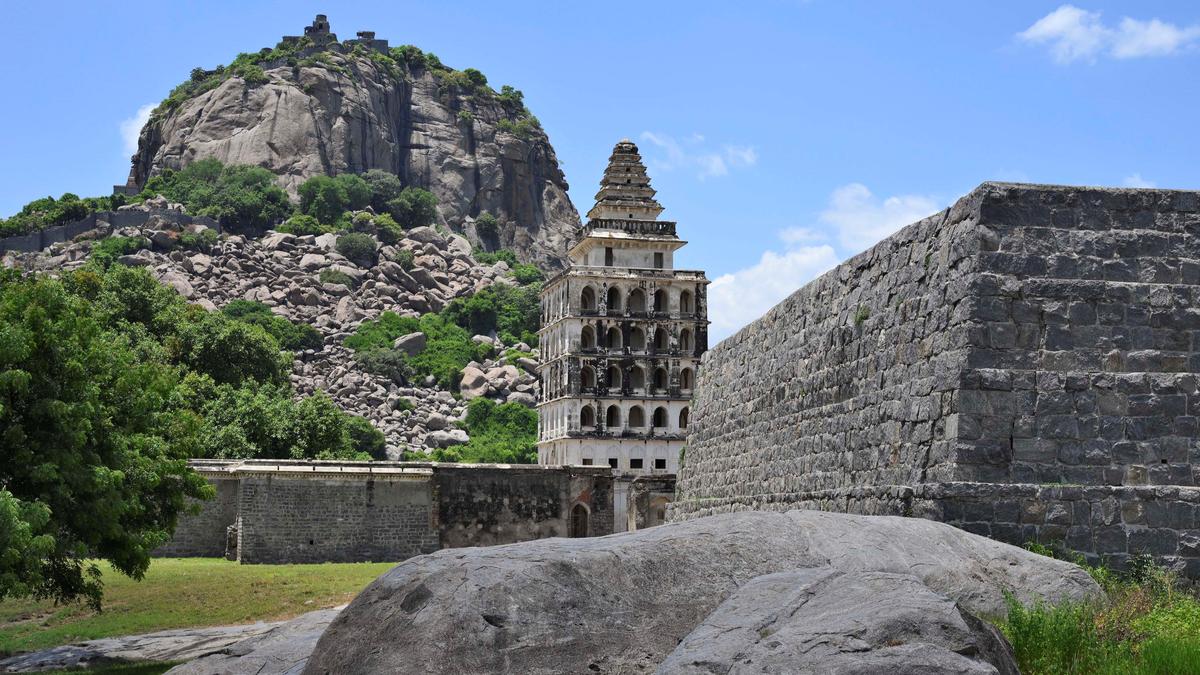GINGEE FORT PROPOSED FOR UNESCO WORLD HERITAGE SITE

- 24 Sep 2024
In News:
Recently nominated for UNESCO’s World Heritage Site status, Gingee Fort is part of the Maratha Military Landscapes of India, which encompasses 12 historical sites, primarily located in Maharashtra, with Gingee being the sole representative from Tamil Nadu. The nomination highlights the fort’s historical importance, unique military architecture, and its integral role in Maratha military history.
Significance of Gingee Fort
Gingee Fort, often referred to as the "Troy of the East," stands as a crucial historical monument in Tamil Nadu. Perched atop three prominent hillocks—Rajagiri, Krishnagiri, and Chandragiri—it has served as a significant stronghold for numerous empires throughout Indian history, including the Vijayanagar Nayaks, Marathas, Mughals, French, and British. This fortification exemplifies India’s rich and diverse historical legacy.
Unique Features
The fort complex spans 11 acres and boasts an array of significant structures, including:
- Kalyana Mahal: An eight-storey royal residence.
- Durbar Hall: A ceremonial hall for gatherings.
- Stepped Well and Cannon: Examples of advanced engineering and military use.
- Clock Tower and Armory: Reflecting its historical military significance.
- Elephant Tank and Stables: Indicating its use for royal elephants.
- Temples and Mosques: Including the Venkataramana Temple with intricate carvings and the Sadathtulla Mosque.
Additionally, the fort features advanced water supply systems from various historical periods, ensuring adequate resources for its inhabitants.
Historical Timeline
The origins of Gingee Fort trace back to 1200 CE when built by Ananta Kon of the Konar Dynasty. The fort underwent significant renovations under the Vijayanagar Empire. Key historical events include:
- 1677: Captured by Chhatrapati Shivaji, it remained under Maratha control until 1698.
- 1698: Came under Mughal possession, later ruled by the Nawabs of Arcot and briefly by the French.
- 1750-1770: Occupied by the French before falling to the British.
This timeline reflects the fort's strategic and cultural significance across different dynasties.
Nomination Process for UNESCO
The process for securing UNESCO World Heritage Site status involves rigorous evaluation. Experts from UNESCO and the International Council on Monuments and Sites (ICOMOS) assess the site's historical significance, conservation state, and management strategies. A visit to Gingee Fort is scheduled as part of this evaluation, with a recommendation expected for the 2025 World Heritage designation.
Preparation of the Nomination Dossier
The Development and Research Organisation for Nature, Arts and Heritage (DRONAH) prepared the nomination dossier, aligning with UNESCO’s operational guidelines. This comprehensive document details the fort's historical context, conservation status, and management strategies, aimed at demonstrating its outstanding value for humanity.
Memory of the World (MoW) Programme

- 15 May 2024
Why is it in the News?
Three Indian literary works, Ramcharitmanas, Panchatantra, and Sah?dayaloka-Locana, were added to UNESCO’s Memory of the World Asia-Pacific Regional Register during the tenth meeting of the Memory of the World Committee for Asia and the Pacific (MOWCAP).
About Memory of the World Programme:
- The Memory of the World (MoW) Programme is an international initiative by UNESCO launched in 1992 aimed at preserving and recognizing the world's significant documentary heritage.
- The program's objective is to identify and protect important documents in a manner similar to how UNESCO's World Heritage Convention and World Heritage List recognize significant natural and cultural sites.
The Memory of the World Programme aims to:
-
- Facilitating the preservation of documentary heritage, particularly in conflict-affected areas or regions impacted by natural disasters.
- Enabling universal access to documentary heritage worldwide.
- Enhancing public awareness about the significance of documentary heritage among the wider public.
Governance Body:
- The International Advisory Committee (IAC) serves as the main governing body for the MoW Programme, providing guidance to UNESCO on its planning and implementation.
- The IAC comprises 14 members appointed by UNESCO's Director-General, who are chosen for their expertise and authority in the field of documentary heritage.
Nominations for MoW:
- Nominations for inscription on the Asia Pacific Register are called every two years, alternating with the International Register.
- In even-numbered years, nominations are accepted for the Asia Pacific Register.
India has three items included in the Memory of the World Register:
- Ramcharitmanas: Written by Tulasidas in the 16th century in the Awadhi dialect, this text holds immense cultural and literary significance in the regions of Lucknow, Prayagraj, and Ayodhya.
- Panchatantra: This ancient Indian collection of fables, originally written in Sanskrit, consists of five sections that revolve around specific principles.
- It is widely believed to have been authored by Vishnu Sharma.
- Sah?day?loka-Locana: A Sanskrit commentary on the Dhvanyaloka, Sah?day?loka-Locana holds significant historical and literary value within India's rich cultural landscape.
- Through the Memory of the World Programme, UNESCO continues to protect and celebrate the diverse documentary heritage of humanity, ensuring its preservation and accessibility for future generations.
World Craft Council International

- 20 Apr 2024
Why is it in the News?
The World Crafts Council International (WCCI), a Kuwait-based organization working on the recognition and preservation of traditional crafts across the globe, has picked Srinagar for mapping its craft clusters before its final nomination as the World Craft City (WCC) from India this year.
About World Crafts Council:
- World Crafts Council AISBL is an international non-profit organization dedicated to fostering the preservation, promotion, and advancement of global craftsmanship and traditional crafts.
- It was founded by Ms. Aileen Osborn Vanderbilt Webb, Ms. Margaret M. Patch, and Smt Kamaladevi Chattopadhyay at the 1st World Crafts Council General Assembly in New York on June 12, 1964.
- Since its inception, the World Crafts Council AISBL has been affiliated with UNESCO under Consultative Status for many years.
- Its mission is to empower artisans, celebrate cultural diversity, and contribute to sustainable development by supporting the rich tapestry of global craftsmanship and preserving languishing crafts from extinction.
- Headquarters: The current headquarters for the term (2021-2024) is located in Kuwait.
Objectives:
- The main objective of the World Crafts Council AISBL is to strengthen the status of crafts in cultural and economic life.
- The Council aims to promote fellowship among craftspersons by offering them encouragement, help, and advice.
- It fosters and assists cultural exchange through conferences, international visits, research studies, lectures, workshops, exhibitions, and other activities.
- The WCC also seeks to foster wider knowledge and recognition of the craftspeople's work with due regard to the diversified cultural and national backgrounds and traditions of its members.
- In carrying out these principles, the Council shall consult with governments, national and international institutions, societies, and individuals.?
India has only 3 cities designated as World Craft City:
- Mysuru (Kinnal paintings, Sandalwood carvings, Rosewood Inlay, etc.)
- Mamallapuram (Stone Carving continuing since the Pallava dynasty (275 CE to 897 CE)
- Jaipur (Kundan Jadai (Gem setting), Meenakari Jewellery, Lac-based craft, Gotta Patti Work, etc.)
About the World Craft City Programme:
- The World Craft City Programme, initiated in 2014 by the World Crafts Council AISBL (WCC-International), recognizes the significance of local authorities, artisans, and communities in global cultural, economic, and social advancement.
- By establishing a vibrant network of craft cities worldwide, it embraces the ideals of the creative economy and acknowledges the valuable contributions of local entities to comprehensive development.
- Notably, Jaipur (Rajasthan), Mamallapuram (Tamil Nadu), and Mysore have already been designated as craft cities under this initiative in India.
Six Heritage Sites on Tentative UNESCO List

- 20 Mar 2024
Why is it in the News?
In a significant boost to its rich cultural and historical legacy, 6 new sites from Madhya Pradesh have found a place in the tentative UNESCO list of World Heritage Sites (WHS).
Six New Sites From MP In the UNESCO Tentative List:
- The sites included in the tentative list are Gwalior Fort, the Historical Group of Dhamnar, Bhojeshwar Mahadev Temple, Rock Art Sites of Chambal Valley, Khooni Bhandara, Burhanpur, and God Memorial of Ramnagar, Mandla.
- The UNESCO tentative list includes those that provide a forecast of the properties that a State Party may decide to submit for inscription in the next five to ten years.
- Gwalior Fort: An imposing fortress atop a hill, featuring impenetrable walls, exquisite sculptures, and stunning architecture.
- Built-in the 6th century AD by Rajput warrior Suraj Sen and expanded by Tomar ruler Maan Singh in 1398.
- Dhamnar Caves: Rock-cut temple site in Mandsaur district, constructed in the 7th century AD.
- It comprises 51 caves, stupas, chaityas, and dwellings, with a colossal Gautam Buddha statue.
- Bhojeshwar Mahadev Temple: Located near Bhopal, this temple is dedicated to Lord Shiva, with a huge Linga carved from a single stone.
- Built between 1010 and 1053 AD by Raja Bhoj but was never completed.
- Chambal Valley Rock Art Sites: The world's largest concentration of rock art sites across MP, Rajasthan, and Uttar Pradesh, depicting ancient daily life, rituals, and hunting scenes.
- Khooni Bhandara: A unique water supply system built in Burhanpur in 1615 by ruler Abdurrahim Khankhana, still operational today.
- Gond Statue, Mandla: Moti Mahal, a five-storied palace built in Mandla in 1667 by Gond king Hriday Shah, showcasing the strong willpower of the king despite limited resources.
What is UNESCO’s Tentative List?
- A World Heritage Site is a site with outstanding universal value.
- It also denotes cultural and natural significance that transcends national boundaries and is of common importance for current and future generations of all humanity.
- According to UNESCO, a tentative list lists the properties each State Party intends to consider for nomination.
- The government of any nation must have a nomination document ready for the UNESCO World Heritage Committee to review once as soon as UNESCO includes it in a location on the Tentative List.
- After this, a UNESCO representative will evaluate the situation and inspect it.
What is the Tentative List Process?
- The States Parties are encouraged to submit their Tentative Lists of properties that they consider cultural and natural heritage of outstanding universal value and, therefore, suitable for inscription on the World Heritage List.
- The States Parties are encouraged to prepare their Tentative Lists with the participation of stakeholders such as site managers, local and regional governments, local communities, NGOs, and other interested parties and partners.
- The States Parties should submit the Tentative Lists to the World Heritage Centre at least one year before submitting any nomination.
- The list should not be exhaustive.
- The States Parties can re-examine and re-submit their list at least every ten years.
- The States Parties are also requested to submit their lists using a submission format (English or French) that should contain the name of the properties, geographical location, a brief description of the properties, and why the property is of outstanding universal value.
- Nomination will only be considered once the property is added to the State Party's Tentative List.
Will the ‘Paruveta Festival’ celebrated in Andhra’s Ahobilam get UNESCO recognition?

- 22 Feb 2024
Why is it in the News?
INTACH is striving to obtain UNESCO recognition for the yearly 'Paruveta' festival, emphasising its cultural significance.
About the Paruveta Festival:
- Paruveta Festival, also known as the 'mock hunting festival', is a celebrated tradition at the Sri Narasimha Swamy temple in Ahobilam, Andhra Pradesh.
- It stands out as a symbol of communal harmony, where devotees from various religious backgrounds, including Muslims, come together to offer prayers.
Origin and Significance:
- According to folklore, the festival commemorates Lord Vishnu's incarnation as Narasimha, who married Chenchulakshmi, a tribal girl, symbolising unity across different communities.
- The festival's rituals, typically observed during Vijayadashami or Sankranti, extend for a 'mandala' period of forty days in Ahobilam.
Activities and Customs:
- During the festival, the temple deity is carried to the 32 Chenchu tribal villages surrounding Ahobilam for forty days.
- The journey begins with a symbolic act where tribals shoot arrows at the deity's palanquin, signifying protection and reverence.
- Chenchus participated by undertaking 'Narasimha Deeksha', wearing yellow robes and Tulasi Mala, while observing celibacy.
- The temple staff reside in these villages throughout the festival, showcasing the tradition of a casteless society with no traces of untouchability.
Key Points about Chenchu Tribes:
- Geographic Distribution: Chenchu tribes primarily inhabit the hills of southern India, particularly in Andhra Pradesh.
- Additionally, Chenchu communities can be found in Tamil Nadu, Karnataka, and Orissa.
- Language and Communication: Their native language, known as Chenchu, belongs to the Dravidian language family.
- While many Chenchu individuals speak Telugu, their traditional language holds cultural significance.
- Livelihood and Occupation: Historically, Chenchu people pursued a nomadic lifestyle, relying on food gathering.
- However, due to factors such as agricultural expansion, many have transitioned to working as farmers or forest labourers.
- Housing and Settlements: Chenchu dwellings are typically hive-shaped structures constructed from wattle thatch, composed of interwoven poles, twigs, reeds, or branches.
- These houses reflect their traditional architectural style and are adapted to their environment.
- Social Structure: Chenchu society is organised into clans, which are extended family units, as well as local groups and individual families.
- They adhere to exogamous marriage practices, prohibiting unions within the same clan.
- Additionally, Chenchu kinship is patrilineal, tracing descent through male lineage.
'Maratha Military Landscapes' to be India's nomination for UNESCO World Heritage List for 2024-25 (The Hindu)

- 30 Jan 2024
Why is it in the News?
'Maratha Military Landscapes' representing extraordinary fortification and military system envisioned by the Maratha rulers will be India's nomination for inclusion in the UNESCO World Heritage List for the 2024-25 cycle, the Culture Ministry said on January 29.
About Maratha Military Landscapes:
- Developed between the 17th and 19th centuries, the nomination comprises the 12 components of Salher Fort, Shivneri Fort, Lohgad, Khanderi Fort, Raigad, Rajgad, Pratapgad, Suvarnadurg, Panhala Fort, Vijaydurg, Sindhudurg in Maharashtra, and Gingee Fort in Tamil Nadu.
- These components are strategically distributed across diverse geographical and physiographic regions, highlighting the military prowess of the Maratha rule.
- The landscapes showcase the integration of landscape, terrain, and physiographic characteristics distinctive to the Sahyadri mountain ranges, the Konkan Coast, the Deccan Plateau, and the Eastern Ghats in the Indian Peninsula.
- Out of the more than 390 forts in Maharashtra, only 12 have been chosen under the 'Maratha Military Landscapes of India'.
- The inception of the Maratha Military ideology dates back to the 17th century during the reign of the Maratha King Chhatrapati Shivaji Maharaj, continuing through subsequent rules until the Peshwa rule of 1818 CE.
UNESCO Nomination Criteria:
- There are two categories of nomination- cultural and natural criteria.
- The Maratha Military Landscapes is nominated under cultural criteria.
- To fulfil this criterion, a site should bear unique testimony to cultural tradition, it should be an outstanding example of a type of building, architectural or technological ensemble, or landscape that illustrates significant stage(s) in human history and it should be directly or tangibly associated with events or living traditions, ideas or beliefs, artistic and literary works of outstanding universal significance.
World Heritage Sites In India:
- India presently boasts 42 World Heritage sites, with 34 cultural sites, 7 natural sites, and 1 mixed site.
- Maharashtra alone has six World Heritage Sites including:
- The Ajanta Caves
- Ellora Caves
- Elephanta Caves
- Chhatrapati Shivaji Maharaj Terminus
- Victorian Gothic and Art Deco Ensembles of Mumbai, and
- The Western Ghats (a natural site)
Tentative List Recognition:
- The Maratha Military Landscapes of India, included in the Tentative List of World Heritage sites in 2021, is the sixth cultural property nominated for inclusion in the World Heritage List from Maharashtra.
‘Garba Of Gujarat’ Declared as Intangible Cultural Heritage by UNESCO (Indian Express)

- 07 Dec 2023
Why is it in the News?
Garba, the folk art of Gujarat, receives the intangible cultural heritage of humanity (ICH) tag from Unesco.
Context:
- 'Garba of Gujarat' has been inscribed in the Representative List of Intangible Cultural Heritage (ICH) of Humanity by UNESCO.
- The decision was taken at the 18th session of the UNESCO’s Intergovernmental Committee for Safeguarding of Intangible Cultural Heritage held in the Republic of Botswana.
- Garba of Gujarat is the 15th ICH element from India to join this list.
- This inscription underscores Garba’s pivotal role as a unifying force that fosters social and gender inclusivity.
About Garba Dance:
- Garba is a ritualistic and devotional dance deeply rooted in the traditions of Gujarat, India.
- This vibrant dance is a central part of the nine-day Navratri festival, dedicated to the worship of feminine energy or Shakti.
- The cultural richness of Garba vividly expresses the divine feminine through its performances and visuals.
- Taking place in various settings, from homes and temple courtyards to public spaces, streets, and open grounds, Garba transforms into a widespread, inclusive community celebration.
- Beyond its religious significance, Garba serves as a social equalizer, breaking down barriers related to socio-economic status, gender, and sect divisions.
- This inclusive dance form fosters community unity, bringing together diverse and marginalized groups and reinforcing social bonds.
- Notably, Garba holds the distinction of being the 15th cultural element from India to be recognized by UNESCO.
What is Intangible Cultural Heritage?
- Cultural heritage extends beyond physical structures and object collections.
- It encompasses traditions and living expressions transmitted from our forebears to descendants.
- This includes oral traditions, performing arts, social practices, rituals, festive events, and the knowledge associated with nature, the universe, as well as the skills involved in traditional craftsmanship.
Three heritage projects in Punjab and Haryana bag UNESCO Asia-Pacific Awards 2023 (Business Standard)

- 23 Dec 2023
Why is it in the News?
The resilient urban revitalisation of Rambagh Gate and Ramparts in Punjab, and heritage conservation projects related to Haryana's Church of Epiphany and Delhi's Bikaner House won Unescoawards on Thursday.
About Rambagh Gate & Ramparts:
- A three-story architectural marvel, the Rambagh Gate underwent meticulous restoration employing traditional building techniques.
- Locally sourced materials, including Nanak Shahi bricks set in lime mortar, were integral to the restoration process.
About Pipal Haveli, Gurdaspur:
- Pipal Haveli in Gurdaspur stands as a testament to ecological and traditional building methods, incorporating locally sourced materials and embracing vernacular architectural language.
- Notably, it actively promotes women's empowerment through initiatives like the BaRi Collective, offering programs that enhance women's livelihoods through environmentally conscious craft practices.
What is the UNESCO Asia-Pacific Awards for Cultural Heritage Conservation?
- UNESCO aims to promote private sector engagement and foster collaborations between the public and private sectors to preserve the cultural heritage of the Asia-Pacific region for the benefit of present and future generations.
- Since the year 2000, the UNESCO Asia-Pacific Awards for Cultural Heritage Conservation have been acknowledging the accomplishments of private sector entities and public-private initiatives in effectively conserving or restoring structures, places, and properties of significant heritage value in the region.
- Noteworthy, among the recognized sites, five are located in China, six in India, and one in Nepal.
- Highlights of Award-Winning Sites in India:
- Rambagh Gate in Amritsar: Received the prestigious "Award of Excellence," the highest recognition across all categories.
- Pipal Haveli in Punjab: Honored for its sustainable development as a heritage rural homestay.
- Karnikara Mandapam at Kunnamangalam Bhagawati Temple in Kerala: Earned the esteemed "Award of Distinction."
- Epiphany in Haryana, David Sassoon Library and Reading Room in Mumbai, and Bikaner House in New Delhi: Recognized with the "Award of Merit" for their outstanding contributions to cultural heritage conservation.
India’s First ‘City Of Literature’ (Money Control)

- 01 Nov 2023
Why in the News?
Kozhikode, in Kerala, was named the ‘City of Literature’ by the Unesco Creative Cities Network (UCCN), making it the first such city in India.
About India’s First ‘City Of Literature’:
- Kozhikode (Kerala), has achieved global recognition by joining the UNESCO Creative Cities Network.
- It is now known as the 'City of Literature,' making it the first Indian city to receive this prestigious title.
- This recognition was awarded on World Cities Day, (31 October) along with Gwalior, Madhya Pradesh, which was designated a 'City of Music.'
- Prague was the first city to receive the 'City of Literature' title in 2014.
About UNESCO Creative Cities Network:
- The UNESCO Creative Cities Network is a global initiative established by the United Nations Educational, Scientific, and Cultural Organization (UNESCO) to recognize and promote cities that have made significant contributions to the development of creative industries and culture.
- The UNESCO Creative Cities Network now comprises 350 creative cities from over 100 countries.
- These cities represent seven creative fields, including Crafts and Folk Art, Design, Film, Gastronomy, Literature, Media Arts, and Music.
- Participation in the UNESCO Creative Cities Network provides cities with opportunities for international collaboration, knowledge sharing, and the exchange of best practices in creative and cultural endeavours.
- These cities serve as hubs for artistic expression, cultural preservation, and economic growth, making them vital players in the global creative economy.
- Through this network, cities work together to harness the power of culture and creativity to address common challenges and promote sustainable development, ultimately enhancing their status on the global stage.
